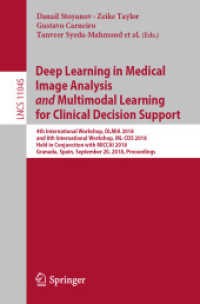- ホーム
- > 洋書
- > 英文書
- > Politics / International Relations
Full Description
In a sophisticated combination of quantitative research and two in-depth case studies, Larisa Deriglazova surveys armed conflicts post World War II in which one power is much stronger than the other. She then focuses on the experiences of British decolonization after World War II and the United States in the 2003 Iraq war. Great Powers, Small Wars employs several large databases to identify basic characteristics and variables of wars between enemies of disproportionate power. Case studies examine the economics, domestic politics, and international factors that ultimately shaped military events more than military capacity and strategy.
Contents
List of Tables
List of Figures
Preface: Asymmetric Conflicts: An Equation With Many Unknowns
Acknowledgments
1. Origin and Development of the Asymmetric Conflict Concept
Postwar Peace: From Total War to Asymmetric Conflicts
Critical Approaches to the Concept of Asymmetric Conflict
Defining Asymmetric Conflict
Developing an Analytical Model of Asymmetric Conflict
2. Identifying the Asymmetry Factor in Armed Conflicts
Data Sources and Methods of Analysis
Identifying Asymmetry in the Structural and Dynamic Characteristics of Armed Conflicts
Impact of the Asymmetry Factor on Conflicts Involving the Great Powers
Conclusions
3. The Dissolution of the British Empire and Asymmetric Conflicts in Dependencies
The Dissolution of the British Empire
Asymmetric Armed Conflicts Accompanying the Colonies' Struggle for Independence
Factors in the British Political Defeat in Asymmetric Conflicts in Its Colonies
Conclusion
4. The US War in Iraq, 2003-2011
The War's Objectives and Legitimation of the War's Cause
Course of the War and the Evolution of Strategies
The War's Outcomes
Discussion of the War's Outcome in the United States
Conclusions
Conclusion: Analyzing Asymmetric Conflicts Using the Model
Appendix: List of Armed Conflicts from the Cosimo Database Used in the Study
Notes
Index








